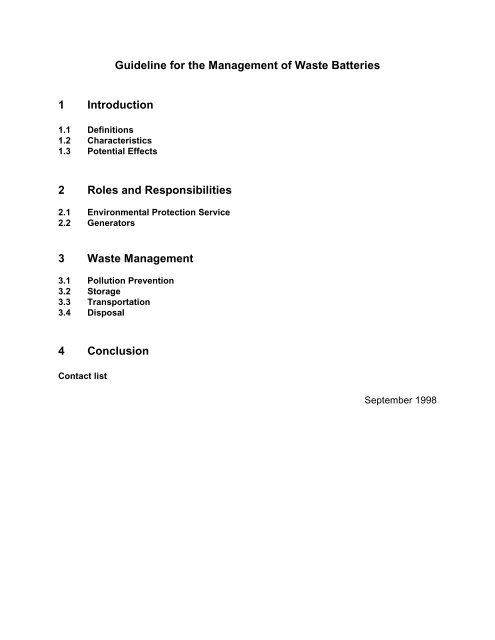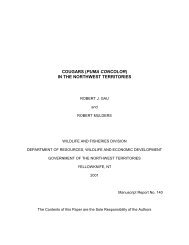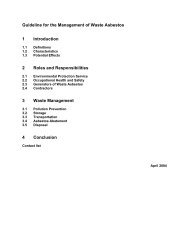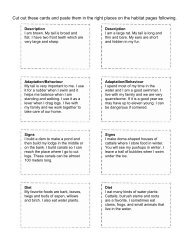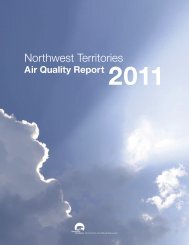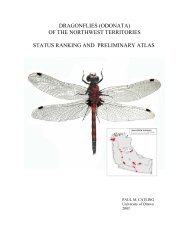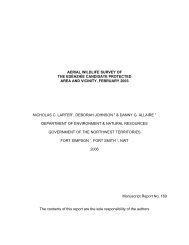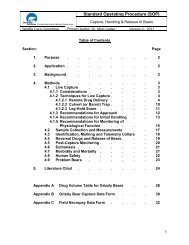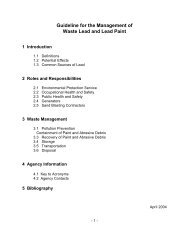Guideline on Waste Batteries - Environment and Natural Resources ...
Guideline on Waste Batteries - Environment and Natural Resources ...
Guideline on Waste Batteries - Environment and Natural Resources ...
You also want an ePaper? Increase the reach of your titles
YUMPU automatically turns print PDFs into web optimized ePapers that Google loves.
<str<strong>on</strong>g>Guideline</str<strong>on</strong>g> for the Management of <strong>Waste</strong> <strong>Batteries</strong>1 Introducti<strong>on</strong>1.1 Definiti<strong>on</strong>s1.2 Characteristics1.3 Potential Effects2 Roles <strong>and</strong> Resp<strong>on</strong>sibilities2.1 Envir<strong>on</strong>mental Protecti<strong>on</strong> Service2.2 Generators3 <strong>Waste</strong> Management3.1 Polluti<strong>on</strong> Preventi<strong>on</strong>3.2 Storage3.3 Transportati<strong>on</strong>3.4 Disposal4 C<strong>on</strong>clusi<strong>on</strong>C<strong>on</strong>tact listSeptember 1998
<str<strong>on</strong>g>Guideline</str<strong>on</strong>g> for the Management of <strong>Waste</strong> <strong>Batteries</strong>1 Introducti<strong>on</strong>This guideline provides general informati<strong>on</strong> <strong>on</strong> the proper management of waste batteries.<strong>Waste</strong> batteries are a c<strong>on</strong>taminant under the Envir<strong>on</strong>mental Protecti<strong>on</strong> Act (EPA) of the NWT<strong>and</strong> must be managed as a hazardous waste.Storage batteries are a source of direct electric current produced by reacti<strong>on</strong> of the chemicals inthe battery. In rechargeable batteries, the chemical reacti<strong>on</strong> is reversible <strong>and</strong> therefore they canbe recharged many times. Eventually however, even the best rechargeable batteries reach theend of their useful life <strong>and</strong> become wastes. All batteries c<strong>on</strong>tain a corrosive liquid or semi-liquidelectrolyte that is either a str<strong>on</strong>g acid or a str<strong>on</strong>g base. In additi<strong>on</strong>, batteries c<strong>on</strong>tain metals,such as cadmium, lead, lithium <strong>and</strong> potassium, which generally are toxic <strong>and</strong> persist in theenvir<strong>on</strong>ment.This guideline addresses lead acid batteries <strong>and</strong> rechargeable batteries. Lead batteries (i.e.car batteries) c<strong>on</strong>tain sulphuric acid <strong>and</strong> lead. Rechargeable batteries (i.e. industrial forklift,radio <strong>and</strong> transmitter batteries) usually c<strong>on</strong>tain either potassium hydroxide or nickel cadmium.<strong>Batteries</strong> in domestic products like radios <strong>and</strong> flash lights, (examples: AAA to D cells, 6 or 9volt c<strong>on</strong>sumer batteries) are not included in this guideline. Butt<strong>on</strong> batteries however, mayc<strong>on</strong>tain mercury, cadmium <strong>and</strong> silver <strong>and</strong> should be dropped off at ”Household Hazardous<strong>Waste</strong> Days” locati<strong>on</strong>s operated by the municipality.This guideline is specific to the management of waste batteries <strong>and</strong> should be read inc<strong>on</strong>juncti<strong>on</strong> with the <str<strong>on</strong>g>Guideline</str<strong>on</strong>g> for the General Management of Hazardous <strong>Waste</strong> in the NWT(referred to as the General <str<strong>on</strong>g>Guideline</str<strong>on</strong>g>). Secti<strong>on</strong> 2.2 of the EPA gives the Minister of <strong>Resources</strong>,Wildlife <strong>and</strong> Ec<strong>on</strong>omic Development the authority to develop, coordinate <strong>and</strong> administer theseguidelines.1.1 Definiti<strong>on</strong>sGeneratorTransport authorityThe owner or pers<strong>on</strong> in charge, management or c<strong>on</strong>trol of a hazardouswaste at the time it is generated or a facility that generates hazardouswaste.The regulati<strong>on</strong>s c<strong>on</strong>trolling the management of hazardous waste underthat mode of transport. These include:Road <strong>and</strong> rail - Transportati<strong>on</strong> of Dangerous Goods Act (TDGA) <strong>and</strong>Regulati<strong>on</strong>s (TDGR)Air - Internati<strong>on</strong>al Civil Aviati<strong>on</strong> Organizati<strong>on</strong> Technical Instructi<strong>on</strong>s(ICAO)Marine - Internati<strong>on</strong>al Maritime Dangerous Goods Code (IMDG).- 1 -
<strong>Waste</strong> batteriesA general term used to describe spent electrical storage batteries whichare no l<strong>on</strong>ger useful for their intended purpose <strong>and</strong> are intended forstorage, recycling, treatment or disposal. Examples of waste batterytypes include: lead acid; potassium hydroxide; nickel cadmium. For thepurpose of this guideline, waste batteries do not include dry cell sizeAAA to D, 6 or 9 volt domestic batteries.1.2 CharacteristicsHazards from waste batteries are associated with improper h<strong>and</strong>ling <strong>and</strong> disposal. Improperh<strong>and</strong>ling can release corrosive fluids that can cause chemical burns <strong>and</strong> damage to a widevariety of materials. Metals in batteries, including lead, mercury <strong>and</strong> cadmium, are toxic <strong>and</strong>bioaccumulate in plants <strong>and</strong> animals. They also persist in the envir<strong>on</strong>ment.1.3 Potential EffectsImproper h<strong>and</strong>ling of waste batteries can result in the spillage of corrosive materials. Thecorrosive materials c<strong>on</strong>tain dissolved metals that are toxic to plants <strong>and</strong> animals. Improperdisposal of batteries in l<strong>and</strong>fill sites may result in the release of corrosive fluids <strong>and</strong> dissolvedmetals into groundwater <strong>and</strong> the envir<strong>on</strong>ment.2 Roles <strong>and</strong> Resp<strong>on</strong>sibilities2.1 Envir<strong>on</strong>mental Protecti<strong>on</strong> ServiceThe Envir<strong>on</strong>mental Protecti<strong>on</strong> Service (EPS) of the Department of <strong>Resources</strong>, Wildlife <strong>and</strong>Ec<strong>on</strong>omic Development is the Government of the Northwest Territories’(GNWT) agencyresp<strong>on</strong>sible for initiatives which c<strong>on</strong>trol the discharge of c<strong>on</strong>taminants <strong>and</strong> their impact <strong>on</strong> theenvir<strong>on</strong>ment. EPS is resp<strong>on</strong>sible for ensuring that envir<strong>on</strong>mentally acceptable managementprocedures, emissi<strong>on</strong> levels <strong>and</strong> disposal methods are maintained. EPS programs are appliedprimarily to Commissi<strong>on</strong>er’s L<strong>and</strong>, l<strong>and</strong>s administered by municipal governments or GNWTundertakings. Legislative authority is provided by the EPA <strong>and</strong> Pesticide Act. C<strong>on</strong>tact EPS fora listing of relevant regulati<strong>on</strong>s <strong>and</strong> guidelines.2.2 GeneratorsThe resp<strong>on</strong>sibility for proper waste management rests with the generator <strong>and</strong>should be c<strong>on</strong>sidered as part of the cost of doing business.Every pers<strong>on</strong> who generates waste batteries is resp<strong>on</strong>sible for the proper management of thesematerials. <strong>Waste</strong> batteries must be safely h<strong>and</strong>led, packaged, stored, transported, treated<strong>and</strong>/or disposed in accordance with this guideline <strong>and</strong> all applicable Acts <strong>and</strong> regulati<strong>on</strong>s.- 2 -
3 <strong>Waste</strong> ManagementMinimizing or avoiding the creati<strong>on</strong> of pollutants <strong>and</strong> wastes can be more effectivein protecting the envir<strong>on</strong>ment than treating them, or cleaning them up after theyhave been created.3.1 Polluti<strong>on</strong> Preventi<strong>on</strong>Canadian Council of Ministers of the Envir<strong>on</strong>mentPolluti<strong>on</strong> preventi<strong>on</strong> methods reduce or eliminate the generati<strong>on</strong> of waste products. Polluti<strong>on</strong>c<strong>on</strong>trol opti<strong>on</strong>s treat waste after it has been created. Polluti<strong>on</strong> preventi<strong>on</strong> strategies forbatteries include the following:Reduce? Maintain <strong>and</strong> protect batteries to prevent damage <strong>and</strong> charge loss.? Test batteries prior to disposal to c<strong>on</strong>firm the battery is spent.? Replace n<strong>on</strong>-rechargeable batteries with rechargeable batteries where possible.Recycling? Service batteries to extend the life.? Send spent batteries to recyclers. ( Recyclers reduce a battery into its comp<strong>on</strong>ent parts<strong>and</strong> produce new batteries or manufacture other products. The comp<strong>on</strong>ent parts include;metal, plastics <strong>and</strong> liquid comp<strong>on</strong>ents of the battery.)? Make an agreement with your supplier/distributor of batteries to return the waste batteries.3.2 StorageBattery storage is not a l<strong>on</strong>g term soluti<strong>on</strong>.Store waste batteries according to the following:? Use c<strong>on</strong>tainers that are sound, sealable <strong>and</strong> not damaged or leaking.? Bulk into good quality 16 gauge or lower gauge metal or plastic 205 Litre drums, or otherform of c<strong>on</strong>tainment, as appropriate.? Label c<strong>on</strong>tainers according to the requirements of the Work Site Hazardous MaterialsInformati<strong>on</strong> System (WHMIS) of the Safety Act or the relevant Transport Authority, iftransport is planned.? Keep the c<strong>on</strong>tainers sealed or closed at all times.? Protect from the weather <strong>and</strong> physical damage.? Use wooden pallets to keep the c<strong>on</strong>tainers <strong>and</strong> batteries off the ground during storage <strong>and</strong>transport.? Storage should be in a secure area with c<strong>on</strong>trolled access.? Train pers<strong>on</strong>nel in the safe use, storage <strong>and</strong> shipping procedures for waste batteries.Only trained pers<strong>on</strong>s should have access to the storage area.Temporary storage of waste batteries is <strong>on</strong>ly acceptable as an interim measure to permit timefor the collecti<strong>on</strong> of sufficient volumes for cost effective transport to a recycler or disposalfacility. Storage of batteries in quantities greater than 1000 kilograms for a period greater than- 3 -
180 days requires registrati<strong>on</strong> of the site as an hazardous waste storage facility. C<strong>on</strong>sult theGeneral <str<strong>on</strong>g>Guideline</str<strong>on</strong>g> or c<strong>on</strong>tact EPS for applicati<strong>on</strong> procedures.3.3 Transportati<strong>on</strong>The transportati<strong>on</strong> of waste batteries to a recycling, treatment, disposal or management facilityrequires the proper classificati<strong>on</strong> packaging, labeling <strong>and</strong> manifests for the specific transportauthority (air, marine, rail, road). Specific requirements for waste generators <strong>and</strong> carriers aredetailed in the General <str<strong>on</strong>g>Guideline</str<strong>on</strong>g>.The following are examples of battery packaging requirements for road transport:Singles - Secure batteries upright in a leak proof plastic c<strong>on</strong>tainer or a polyethylene bag <strong>and</strong> tiesecurely.By the Drum - Stack batteries upright inside the drum <strong>and</strong> separate by a layer of adsorbentmaterial, cardboard or plywood. The drums can be metal or plastic but must be maintained inan upright positi<strong>on</strong> <strong>and</strong> sealed during transport.By the Pallet - <strong>Waste</strong> batteries should be fastened to the pallet by nyl<strong>on</strong> straps or other securemeans. Place batteries <strong>on</strong> a leak proof polyethylene c<strong>on</strong>tainment liner which is folded over thebatteries to form a sealed system. Do not stack batteries more than two high <strong>and</strong> separate thetwo layers with cardboard or plywood.- 4 -
For road transportati<strong>on</strong> purposes, waste batteries can be classified in the following ways,depending <strong>on</strong> the type of battery.Shipping Name:Shipping Name:Shipping Name:Shipping Name:Battery, dry, c<strong>on</strong>taining potassium hydroxide solidClassificati<strong>on</strong> 8P.I.N.: UN3028Packing Group III, orBattery, wet, filled with acidClassificati<strong>on</strong> 8P.I.N.: UN2794Packing Group III, orBattery, wet, filled with alkaliClassificati<strong>on</strong> 8P.I.N.: UN2795Packing Group III, orBattery, wet, n<strong>on</strong>-spillableClassificati<strong>on</strong> 8P.I.N.: UN2800Packing Group III.Further c<strong>on</strong>sultati<strong>on</strong> with the transport authority is recommended.Generator, Carrier <strong>and</strong> Receiver numbers, waste manifests <strong>and</strong> registered hazardous wastecarrier lists are available from the Envir<strong>on</strong>mental Protecti<strong>on</strong> Service.3.4 DisposalThe l<strong>on</strong>g term goal for the management of waste batteries is 100% recycling.Bulk batteries for transportati<strong>on</strong> <strong>and</strong> ship to a registered recycling or disposal facility. Thebattery industry is currently exp<strong>and</strong>ing its’product stewardship program <strong>and</strong> are acceptingwaste batteries through distributors for recycling. C<strong>on</strong>tacts for recycling or disposal companiesare available by c<strong>on</strong>tacting the waste management associati<strong>on</strong>s listed in Appendix II of theGeneral <str<strong>on</strong>g>Guideline</str<strong>on</strong>g>.C<strong>on</strong>siderati<strong>on</strong> will be given to proposals for alternate disposal methods that provide a level ofenvir<strong>on</strong>mental protecti<strong>on</strong> equivalent to complying with this guideline. EPS may approve themethod, subject to c<strong>on</strong>diti<strong>on</strong>s.- 5 -
4 C<strong>on</strong>clusi<strong>on</strong>sThis guideline presents a brief introducti<strong>on</strong> into the management of waste batteries. It isintended as a source of basic informati<strong>on</strong> <strong>and</strong> should be read in c<strong>on</strong>juncti<strong>on</strong> with the <str<strong>on</strong>g>Guideline</str<strong>on</strong>g>for the General Management of Hazardous <strong>Waste</strong> in the Northwest Territories.For more informati<strong>on</strong> c<strong>on</strong>tact:1) Envir<strong>on</strong>mental Protecti<strong>on</strong> ServiceDepartment of <strong>Resources</strong>, Wildlife <strong>and</strong> Ec<strong>on</strong>omic Development600, 5102-50 AvenueYellowknife NT X1A 3S8Ph<strong>on</strong>e: (867) 873-7654 Fax: (867) 873-02212) Motor VehiclesDepartment of Transportati<strong>on</strong>76 Capital Drive, Suite 201Hay River NT X0E 1G2Ph<strong>on</strong>e: (867) 874-5000 Fax: (867) 874-60883) Preventi<strong>on</strong> Services Divisi<strong>on</strong>Workers’Compensati<strong>on</strong> BoardBox 8888Yellowknife NT X1A 2R3Ph<strong>on</strong>e: (867) 920-3888 Fax: (867) 873-4596- 6 -


